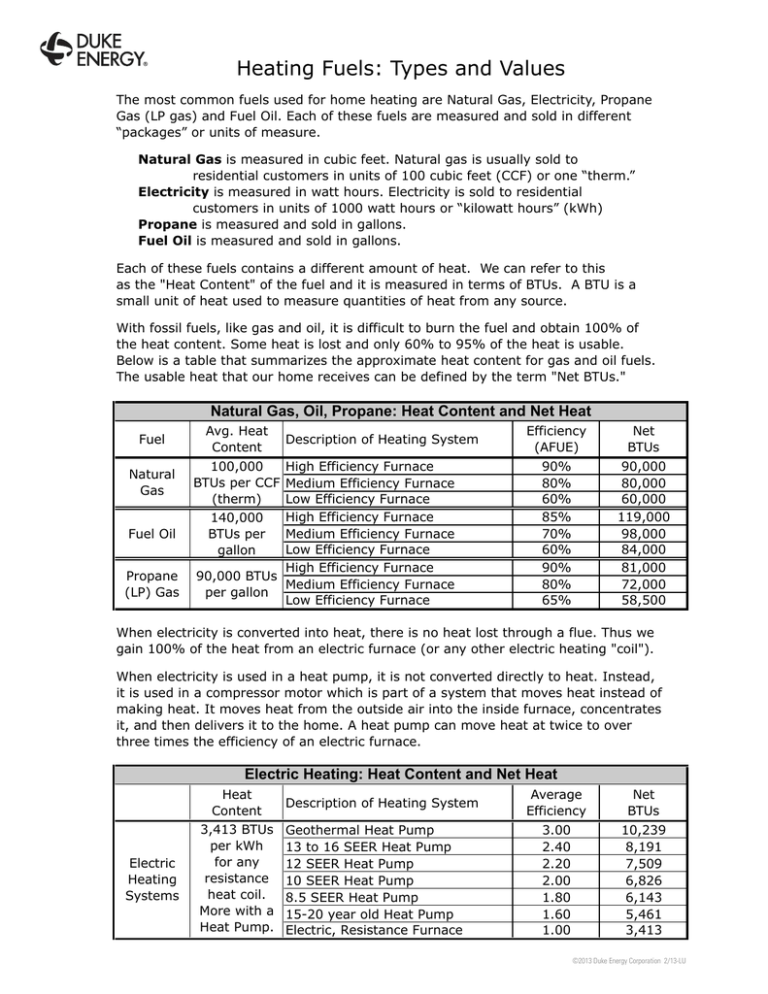Heating Fuels: Types and Values
advertisement

Heating Fuels: Types and Values The most common fuels used for home heating are Natural Gas, Electricity, Propane Gas (LP gas) and Fuel Oil. Each of these fuels are measured and sold in different “packages” or units of measure. Natural Gas is measured in cubic feet. Natural gas is usually sold to residential customers in units of 100 cubic feet (CCF) or one “therm.” Electricity is measured in watt hours. Electricity is sold to residential customers in units of 1000 watt hours or “kilowatt hours” (kWh) Propane is measured and sold in gallons. Fuel Oil is measured and sold in gallons. Each of these fuels contains a different amount of heat. We can refer to this as the "Heat Content" of the fuel and it is measured in terms of BTUs. A BTU is a small unit of heat used to measure quantities of heat from any source. With fossil fuels, like gas and oil, it is difficult to burn the fuel and obtain 100% of the heat content. Some heat is lost and only 60% to 95% of the heat is usable. Below is a table that summarizes the approximate heat content for gas and oil fuels. The usable heat that our home receives can be defined by the term "Net BTUs." Natural Gas, Oil, Propane: Heat Content and Net Heat Fuel Natural Gas Fuel Oil Propane (LP) Gas Avg. Heat Content 100,000 BTUs per CCF (therm) 140,000 BTUs per gallon Description of Heating System High Efficiency Furnace Medium Efficiency Furnace Low Efficiency Furnace High Efficiency Furnace Medium Efficiency Furnace Low Efficiency Furnace High Efficiency Furnace 90,000 BTUs Medium Efficiency Furnace per gallon Low Efficiency Furnace Efficiency (AFUE) Net BTUs 90% 80% 60% 85% 70% 60% 90% 80% 65% 90,000 80,000 60,000 119,000 98,000 84,000 81,000 72,000 58,500 When electricity is converted into heat, there is no heat lost through a flue. Thus we gain 100% of the heat from an electric furnace (or any other electric heating "coil"). When electricity is used in a heat pump, it is not converted directly to heat. Instead, it is used in a compressor motor which is part of a system that moves heat instead of making heat. It moves heat from the outside air into the inside furnace, concentrates it, and then delivers it to the home. A heat pump can move heat at twice to over three times the efficiency of an electric furnace. Electric Heating: Heat Content and Net Heat Electric Heating Systems Heat Content 3,413 BTUs per kWh for any resistance heat coil. More with a Heat Pump. Description of Heating System Geothermal Heat Pump 13 to 16 SEER Heat Pump 12 SEER Heat Pump 10 SEER Heat Pump 8.5 SEER Heat Pump 15-20 year old Heat Pump Electric, Resistance Furnace Average Efficiency Net BTUs 3.00 2.40 2.20 2.00 1.80 1.60 1.00 10,239 8,191 7,509 6,826 6,143 5,461 3,413 ©2013 Duke Energy Corporation 2/13-LU


